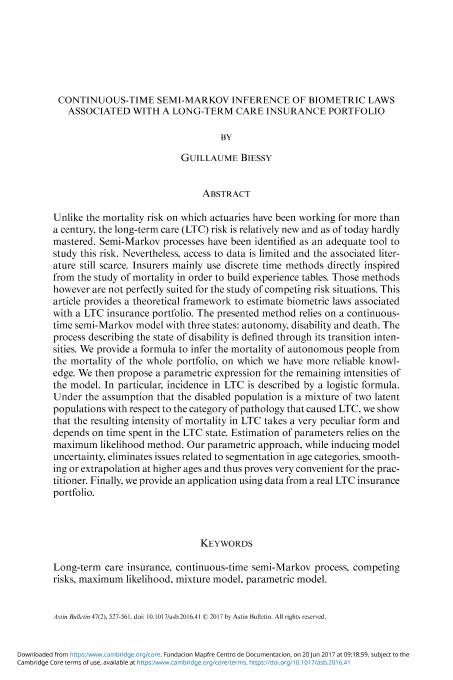Continuous-time semi-markov inference of biometric laws associated with a long-term care insurance portfolio

Contenido multimedia no disponible por derechos de autor o por acceso restringido. Contacte con la institución para más información.
| Tag | 1 | 2 | Value |
|---|---|---|---|
| LDR | 00000cab a2200000 4500 | ||
| 001 | MAP20170019831 | ||
| 003 | MAP | ||
| 005 | 20170621141611.0 | ||
| 008 | 170614e20170501esp|||p |0|||b|spa d | ||
| 040 | $aMAP$bspa$dMAP | ||
| 084 | $a344.1 | ||
| 100 | $0MAPA20170007401$aBiessy, Guillaume | ||
| 245 | 1 | 0 | $aContinuous-time semi-markov inference of biometric laws associated with a long-term care insurance portfolio$cGuillaume Biessy |
| 520 | $aUnlike the mortality risk on which actuaries have been working for more than a century, the long-term care (LTC) risk is relatively new and as of today hardly mastered. Semi-Markov processes have been identified as an adequate tool to study this risk. Nevertheless, access to data is limited and the associated literature still scarce. Insurers mainly use discrete time methods directly inspired from the study of mortality in order to build experience tables. Those methods however are not perfectly suited for the study of competing risk situations. This article provides a theoretical framework to estimate biometric laws associated with a LTC insurance portfolio. The presented method relies on a continuoustime semi-Markov model with three states: autonomy, disability and death. The process describing the state of disability is defined through its transition intensities. We provide a formula to infer the mortality of autonomous people from the mortality of the whole portfolio, on which we have more reliable knowledge. We then propose a parametric expression for the remaining intensities of the model. In particular, incidence in LTC is described by a logistic formula. Under the assumption that the disabled population is a mixture of two latent populations with respect to the category of pathology that caused LTC, we show that the resulting intensity of mortality in LTC takes a very peculiar form and depends on time spent in the LTC state. Estimation of parameters relies on the maximum likelihood method. Our parametric approach, while inducing model uncertainty, eliminates issues related to segmentation in age categories, smoothing or extrapolation at higher ages and thus proves very convenient for the practitioner. Finally, we provide an application using data from a real LTC insurance portfolio. | ||
| 650 | 4 | $0MAPA20160001778$aModelos Semi-Markov | |
| 650 | 4 | $0MAPA20080583972$aCartera de seguros | |
| 650 | 4 | $0MAPA20080555306$aMortalidad | |
| 650 | 4 | $0MAPA20080573867$aSeguro de salud | |
| 773 | 0 | $wMAP20077000420$tAstin bulletin$dBelgium : ASTIN and AFIR Sections of the International Actuarial Association$x0515-0361$g01/05/2017 Volumen 47 Número 2 - mayo 2017 , p. 527-561 |

